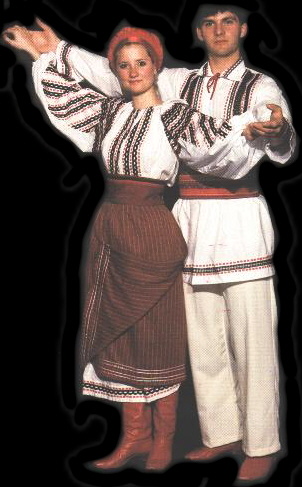BUKOVYNA

Black and red are the predominant colors of this
wardrobe. The ladies blouses have intricate embroidery in black and red
diagonal rows. A brown horbotka hangs atop a long white pidtochka (under
slip). The pidtochka is trimmed with embroidery identical to the blouse.
A red poias and a woven red and gold headpiece complete the outfit. The
men wear shirts with a similar embroidery pattern. The shirts are long,
almost to the knees and are worn over off-white narrow legged pants. A
bright red wool poias gathers the shirt at the waist.
Women
History: The Bukovyna is
closely related to the Podilla region. It was settled by the Tyvertsi tribe
and about the 13th century became a part of the Galician-Volhynian state.
In the 14th century it was conquered by Moldavia and then soon fell under
the Austro-Hungarian empire.
Headwear: Young women parted
their hair in the middle and wore one or two braids. On sundays and holidays
a plaited straw pillbox type hat decorated with flowers and yarn was worn.
Later a tall crown less hat of stiff paper and trimmed with coloured fabric
and ribbons were worn. Stuck into this was sometimes a silky marsh grass
that shimmered in motion when walking or dancing. Married women, as always
the custom, kept their hair covered either by the namitka or a tall pillbox
hat with the hair hidden completely beneath. This was held in place by
a kerchief. The most festive kerchief was of silk and tied around the head
as a turban.
Necklace: At the neck was worn
a woven band of fine beads. Below this were glass beads of many colours.
Then white pearls and finally genuine red coral beads with sometimes silver
coins attached.
Shirt: The shirt was collarless
and cuffless with the edges finished with stitching. It was embroidered
on both sides of the front as well as shoulder panels and sleeves.
Skirt: The horbotka was made
of woven wool and was a wrap around style. It was solid black on the back
with the front having woven in threads. The hem and waist were decoratively
trimmed. A note of interest is that the clothing of the Podilla region
was almost identical. The skirt was worn with one bottom corner hitched
into the sash. It was worn this way for work. On festive occasions both
ends were turned up and tucked into the sash. When entering a church the
woman would always let down the ends.
Apron: No apron was worn over
the hobotka but in later times silk kerchiefs were folded on a diagonal
and worn as aprons.
Sash: These were woven of wool
on small looms and were patterned or striped. Women's narrower than the
men and were long enough to encircle the waist four times.
Vest: Made of sheepskin with
wool to the inside. Edges were usually trimmed in persian lamb and coloured
leather appliqués were used to adorn it. Worn by both men and women.
Footwear: When going out women
wore red or yellow Moroccan leather boots and later a high vamp lace-up
boot.
Men
Headwear: Plaited straw hats
adorned with woven cord were worn in summer. Young men decorated theirs
with rooster feathers. In winter they wore a tall fur hat (kuchma) of
black persian lamb. My grandfathers was grey.
Shirt: Tunic style made of
linen with a standing collar and no cuffs. All edges were stitched . The
shirt was knee length. It tied at the neck with a tasseled cord.
Sash: Woven of woolen yarn
in black and red stripes about the width of a palm and long enough to encircle
the waist about four times. Wide leather belts for work were also worn.
These were about 10-12 inches wide and had two or three buckles.
Footwear: In summer postoly
were worn. For going out boots of soft leather were worn. These had high
bootlegs and folded down about one third.
Info supplied by Kossack's Korner - Jake Kalyta

